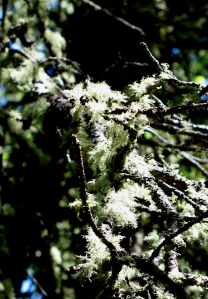At least, that’s how it looks to me. You be the judge.
It seems pretty clear that crustose and foliose lichens are pretty much two-dimensional. They have length and width, but are, we might say, vertically challenged. Fruticose lichens are beyond all that: they may not even have an up or down. One wonders what they might look like growing in zero gravity!
 Fruticose means “shrubby,” and some of these lichens do, in fact, portray shrubs in model railroad layouts or architectural models. Structurally, they vary widely. They may be hollow or solid (as in this Usnea cross-section), but generally have upright forms. Most common here are species of Cladonia, such as “pixie cups,” and Usnea, the beard lichens.
Fruticose means “shrubby,” and some of these lichens do, in fact, portray shrubs in model railroad layouts or architectural models. Structurally, they vary widely. They may be hollow or solid (as in this Usnea cross-section), but generally have upright forms. Most common here are species of Cladonia, such as “pixie cups,” and Usnea, the beard lichens.

Delicate podetia of this Cladonia have flaring cups. Scale provided by nearby aspen leaves. Clear Creek County, CO.

A species of Cladina forms a carpet of white under a young spruce tree. This genus is rare in Colorado; photo is from Maine.
See more examples of Fruticose Lichens:
Old Man’s Beard, the genus Usnea
Stereocaulon, Easy to Spot
Genera of Colorado Fruticose Lichens
- Bryoria See Sharnoff gallery, B. fremontii; see also B. fuscescens, B. lanestris, others.
- Cladina 2 (3) species, now placed back in Cladonia See, for example, Reindeer moss; also at Ways of Enlichenment. Very rare.
- Cladonia 36 species, excluding Cladina See Sharnoff gallery of Cladonia and Cladina species
- Dactylina (Allocetraria) madreporiformis See Sharnoff gallery
- Leprocaulon See Sharnoff gallery, L. gracilescens; see also L. microscopicum, L. subalbicans
- Letharia See Sharnoff gallery, Letharia vulpina. Rare.
- Lobaria See Sharnoff gallery, L. scrobiculata; see also L. pulmonaria. Extremely rare! (Technically considered foliose.)
- Ramalina See Sharnoff gallery, Ramalina pollinaria; see also R. obtusata, R. sinensis
- Stereocaulon See Sharnoff gallery, S. tomentosum; see also S. rivulorum, S. glareosum, S. incrustatum
- Thamnolia See Sharnoff gallery, T. vermicularis
- Usnea See Sharnoff gallery; six species here, U. hirta and U. lapponica probably most common


Pingback: Dark Forests of the San Juan Mountains | Colorado Lichens and Friends